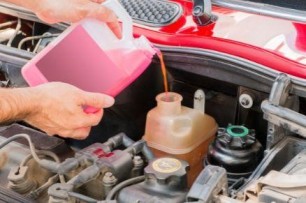Blog Details - Magma HDI

What happens to your car's engine if you drive it without coolant for long 21st March 2022
Much like oil, the coolant in your car is a special fluid that can't be overlooked. Although, in comparison to oil, the coolant needs less attention. Car owners often tend to neglect it, which can severely damage the vehicle and potentially be life-threatening.
This post will give you a clear idea about what will happen if you drive with low or no coolant.
What is coolant?
Coolant is a combination of water and antifreeze. It has a greater boiling point than water, and works at higher temperatures and pressures to regulate the heat generated in the engine. It takes heat from the engine and radiates it back into the atmosphere via your radiator.
Here are the effects of driving with insufficient coolant.
1. Overheating:
The main function of a coolant is to extract heat from the engine. A shortage of coolant may cause your car engine to overheat. If you continue to run an overheated engine, there could be irreversible damage, such as pistons welding to the cylinders.
2. Engine cutoff:
Modern vehicles feature a safety mechanism that will turn off the engine if it suffers considerable damage due to a lack of coolant. Although this function can help you save on engine repairs, it can leave you stranded on the road.
3. Damage to the water pump:
The water pump’s function is to circulate coolant throughout the engine. The pump will continue to run dry if there is insufficient coolant. If the pump goes dry, racks and pockets of air will form in the coolant channel. This increases the pump’s burden and can destroy it permanently.
4. Damage to engine:
The engine blocks are not the only sections that can be damaged by overheating. Many other components can become exposed to heat.
Below is the overview of parts that may suffer the wrath of an overheated engine:
• Head gaskets
• Cams and pulleys
• Warped or bent connector rods
• Crankshaft
• Piston timing
• Connecting rod
5. Decreased mileage:
Your car's engine will be less efficient if you don't have enough coolant. Friction generates more heat, which means more energy is spent. As a result, the fuel efficiency is dismal.
How to identify low coolant levels?
1. Dashboard Warning:
The coolant warning light will light up on your dashboard when car sensors detect a low level of coolant. Keep an eye on your dashboard; it is essential to note that not all cars, especially the older ones, have this feature. Therefore, consider manual checking of the level periodically.
2. A.C. blows hot air:
If your AC unit starts blowing hot air, it is a sign of a lack of coolant.
3. Lower mileage:
Your car starts to consume more fuel per km and shows reduced engine performance.
4. Temperature gauge rise:
The temperature levels of internal components start showing an unexpected spike due to the low level of coolant.
It is vital to make regular coolant checks a habit. If your car's coolant runs out, pull over immediately. Let the engine cool to a safe operating temperature before going to the nearest garage.
If you're unable to drive to a garage, have your car towed to avoid the risk of further damages. Car insurance proves to be a valuable investment in such situations. So, purchase a car insurance policy that provides you with your desired benefits and adds value to your four-wheeler.
Click HERE to invest in ideal car insurance that meets all your requirements.
Disclaimer: The information provided above is for illustrative purposes only. To get more details, please refer to policy wordings and prospectus before purchasing a policy.

